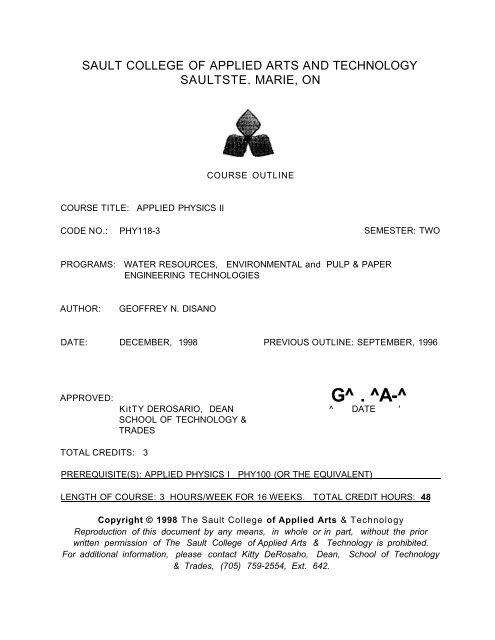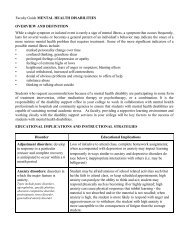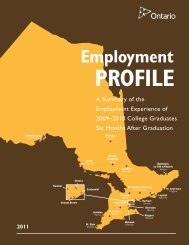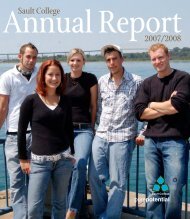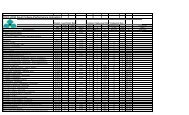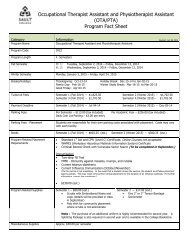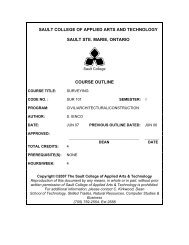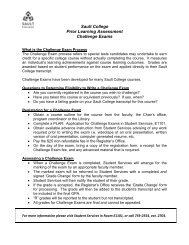PHY118-3 - Applied Physics II Winter 1999.pdf - Sault College
PHY118-3 - Applied Physics II Winter 1999.pdf - Sault College
PHY118-3 - Applied Physics II Winter 1999.pdf - Sault College
Create successful ePaper yourself
Turn your PDF publications into a flip-book with our unique Google optimized e-Paper software.
SAULT COLLEGE OF APPLIED ARTS AND TECHNOLOGYSAULTSTE. MARIE, ONCOURSE OUTLINECOURSE TITLE: APPLIED PHYSICS <strong>II</strong>CODE NO.: <strong>PHY118</strong>-3 SEMESTER: TWOPROGRAMS: WATER RESOURCES, ENVIRONMENTAL and PULP & PAPERENGINEERING TECHNOLOGIESAUTHOR:GEOFFREY N. DISANODATE:DECEMBER, 1998PREVIOUS OUTLINE: SEPTEMBER, 1996APPROVED:KitTY DEROSARIO, DEANSCHOOL OF TECHNOLOGY &TRADESG^ . ^A-^^ DATE 'TOTAL CREDITS: 3PREREQUISITE(S): APPLIED PHYSICS I PHY100 (OR THE EQUIVALENT)LENGTH OF COURSE: 3 HOURS/WEEK FOR 16 WEEKS. TOTAL CREDIT HOURS: 48Copyright © 1998 The <strong>Sault</strong> <strong>College</strong> of <strong>Applied</strong> Arts & TechnologyReproduction of this document by any means, in whole or in part, without the priorwritten permission of The <strong>Sault</strong> <strong>College</strong> of <strong>Applied</strong> Arts & Technology is prohibited.For additional information, please contact Kitty DeRosaho, Dean, School of Technology& Trades, (705) 759-2554, Ext. 642.
COURSE NAME: PAGE 2 CODE NO.<strong>Applied</strong> <strong>Physics</strong> <strong>II</strong><strong>PHY118</strong>-3|I. COURSE DESCRIPTION: This course is the second semester continuation of thesemester one physics course, <strong>Applied</strong> <strong>Physics</strong> i, PHY100. Like it's semesterone prerequisite, the course is intended to introduce the student to a numberof fundamental concepts of physics which should prove useful to students inthe Water Resources, Environmental and Pulp & Paper Engineering Technologyprograms.Topics to be covered include: a review of, and a more in depth study of heat andheat transfer which was introduced in PHY100; a review of, and a more in depthstudy of fluid statics and dynamics which also was introduced in PHY100; the gaslaws; thermodynamics; mechanical properties of solids; static electricity; direct currentelectricity; and magnetism.The assumption is that many of the students will be seeing most of these conceptsfor the first time. Because of the number of topics and the potential for difficulties insome of the more complicated areas, the emphasis will be placed on introducing thestudent to the concepts rather than a rigorous matliematical analysis of the topics.<strong>II</strong>. LEARNING OUTCOMES AND ELEMENTS OF PERFORMANCE:(Generic Skills Learning Outcomes placement on the course outline will be determinedat a later date)A. Learning Outcomes:1) Write definitions for the concepts introduced, preferably in the students ownwords.2) Answer questions requiring a knowledge of the concepts presented in class.3) Respond to questions requiring extrapolation of the course content.4) Solve mathematical based problems requiring an understanding of thecourse theory.5) Apply the knowledge learned in this course to other courses which are 'physicsbased'.
COURSE NAME:<strong>Applied</strong> <strong>Physics</strong> <strong>II</strong>PAGE 3CODE NO.<strong>PHY118</strong>-3B. Topics To Be Covered:Approximate TimeFrames (Optional)I) HEAT AND HEAT TRANSFER<strong>II</strong>) FLUID STATICS AND DYNAMICS<strong>II</strong>I) THE GAS LAWSIV) THERMODYNAMICSV) MECHANICAL PROPERTIES OF SOLIDSVI) STATIC ELECTRICITYV<strong>II</strong>) DIRECT CURRENT ELECTRICITYC. Learning Outcomes and Elements of the Performance:Upon successful completion of this course the student will demonstrate the ability to:I) HEAT AND HEAT TRANSFERa) methods of heat transfer1) Describe in detail the processes involved with each of the three methods ofheat transfer, namely: 'conduction', 'convection' and 'radiation'.2) List the factors that determine the rate at which heat will flow by conductionthrough a surface.3) Write the equation used to determine the amount of heat transferred byconduction through a surface of given surface area and thickness, subjected to agiven temperature difference for a given period of time.4) Describe what Is meant by the term 'R value' and write the equation that relatesthe R value to the 'themial conductivity' of a material.
COURSE NAME: PAGE 4 CODE NO.<strong>Applied</strong> <strong>Physics</strong> il<strong>PHY118</strong>-3)b) specific heat capacity1) Explain the meaning of the term 'specific heat capacity.2) Write an equation for the term 'specific heat capacity^.3) List the units of specific heat capacity in the S.I. metric, C.G.S. metric, "old"M.K.S. metric and Imperial systems of measure.4) Write a definition for the concept of 'sensible heat.5) Write the equation used to determine the 'quantity of sensible heat.6) State the value for the specific heat capacity of water in each of the systems ofmeasure listed in learning activity i-b-3.c) changes of state1) Explain clearly what is meant by a 'change of state'.2) Write the proper term for and discuss the processes that occur for each of thefollowing changes of state: from solid to liquid; from liquid to solid; from liquid togas; from gas to liquid; from solid to gas; from gas to solid.d) specific latent heat of fusion1) Explain the meaning of the term 'specific latent heat effusion'.2) Write an equation for the term 'specific latent heat effusion'.3) List the units of specific latent heat of fusion in the S.I. metric, C.G.S. metric,"old" M.K-S. metric and Imperial systems of measure.4) State the value of the specific latent heat of fusion for water in each of thesystems of measure listed in learning activity l-d-3 above.e) specific latent heat of vapourization1) Explain the meaning of the temri 'specific latent heat of vapourization'.2) Write an equation for the term 'specific latent heat of vapourization'.3) List the units of specific latent heat of vapourization in the S.l. metric, C.G.S.metric, "old" M.K.S. metric and Imperial systems of measure.4) State the value of the specific latent heat of vapourization for water in each of the
i:OURSENAME: PAGES CODE NO.<strong>Applied</strong> <strong>Physics</strong> <strong>II</strong><strong>PHY118</strong>-3systems listed in learning activity l-e-3 above.f) method of mixtures1) Explain what is meant by the concept of 'method of mixtures'.2) Write the main equation used to solve problems involving the 'method ofmixtures'.3) Solve the example problems as presented in class dealing with 'sensible heat,latent heat of fusion', 'latent heat of vapourization' and 'heat loss/heat gain'.4) Review chapter 13 sections 13.2, 13.3, 13.4, 13.5 and 13.8 and solve theproblems as assigned from these sections of the text book.<strong>II</strong>) FLUID STATICS AND DYNAMICSa) pressure1) Write the general equation for the term 'pressure'.2) List the units used to measure pressure in the S.I. metric and the Imperial systemof measurement.3) Identify the relationships that exist among the various units of pressure measurementincluding: pounds per square inch, kilopascals, newtons per square metre,atmospheres, millibars, inches of mercury, centimetres of mercury, millimetres ofmercury, feet of water and metres of water.b) Pressure at a depth in a liquid1) Write the two equations used to determine the pressure exerted by a column ofliquid of known density and depth beneath the surface.2) Discuss the relationship that exists, if it exists at all, between the pressure at agiven depth in a given liquid and the shape of the containing vessel.c) Pascal's law1) Write a verbal statement of Pascal's law and demonstrate an understanding ofthe law by applying it to examples presented in class.2) Solve example problems as presented in class involving applications of Pascal'slaw to hydraulic presses, hydraulic jacks, hydraulic brakes, etc..
COURSE NAME: PAGE 6 CODE NO.<strong>Applied</strong> <strong>Physics</strong> <strong>II</strong><strong>PHY118</strong>-3d) Archimedes' principle1) Demonstrate an understanding of the cause of the force of buoyancy. Do so bydeveloping the relationship that exists between the buoyant force acting on anobject, either submerged or floating, and the weight of the displaced liquid.2) Write a verbal statement of 'Archimedes'principle'an6 demonstrate an understandingof the principle by applying it to examples as presented in class.e) fluid flow1) Discuss what is meant by the terms 'laminar flow'and 'turbulent flow'.2) Write the equations for 'volumetric flow rate', 'mass flow rate' and 'weight flowrate'and indicate clearly the meaning of each of the terms in each of theequations.3) Write a verbal statement of the 'Continuity Principle' and In your own wordsexplain, in simple terms, the implications of this principle.4) Write a mathematical statement (an equation) for the 'Continuity Principle'and solve simple problems involving the flow of an incompressible fluid througha pipe having varying diameters.5) Write a verbal statement for 'Bernoulli's principle'and discuss several applicationsof Bernoulli's principle including the automobile carburetor, an aircraft wing anda baseball pitcher's "curve ball".6) Write a mathematical statement (an equation) for 'Bernoulli's principle'. Indicatewhat each of the quantities in the equation represents, the proper unitsfor each of the terms in the equation and the rational for each of the termshaving these units,7) Read chapter 12 of the reference text.8) Answer the questions and solve the problems as assigned from chapter 12 of thereference text.9) Solve the example and supplementary problems as presented in class dealingwith the flow of an incompressible fluid through a pipe having varying diametersand changing elevations. The relationships between pressure, velocity, elevationand frictional losses are determined by applying Bernoulli's energy equation.
COURSE NAME: PAGE 7 CODE NO,<strong>Applied</strong> <strong>Physics</strong> li<strong>PHY118</strong>-3<strong>II</strong>I) THE GAS LAWSa) Bovle's gas law1) Write a verbal statement of 'Boyle's gas law'.2) Write a mathematical statement (an equation) of 'Boyle's gas law'.3) Explain what is meant by the terms 'gauge pressure' and 'absolute pressure'.4) Write the equation that interrelates the terms 'gauge pressure', 'absolutepressure'and 'atmospheric pressure'.5) List at least a half dozen equivalent expressions for what is known as 'standardatmospheric pressure'.6) Solve the example problems as presented in class dealing with the relationshipbetween the volume and the absolute pressure for a given mass of a gasmaintained at a constant temperature.b) Charles' gas law1) Write a verbal statement of 'Charies'gas law'.2) Write a mathematical statement (an equation) for 'Charies' gas law'.3) Recall from learning activity lX-c-3 from semester one physics, PHY100, therelationship that exists between the Celsius and the Celsius absolute temperaturescale known as the Kelvin scale and the relationship that exists between theFahrenheit and the Fahrenheit absolute temperature scale known as the Rankinescale.4) Solve the example problems presented in class dealing with the relationship thatexists between the volume and the absolute temperature for a fixed mass of gasheld at a constant pressure.c) Gav-Lussac's gas law1) Write a verbal statement of 'Gay-Lussac's gas law'.2) Write a mathematical statement (an equation) for 'Gay-Lussac's gas law'.3) Solve the example problems as presented in class dealing with the relationshipthat exists between the absolute pressure and the absolute temperature of afixed mass of gas held at a constant volume.
COURSE NAME: PAGE 8 CODE NO.<strong>Applied</strong> <strong>Physics</strong> <strong>II</strong><strong>PHY118</strong>-3.d) the general gas law1) Write an equation for the 'general gas law' indicating clearly the meaning of allterms.2) Solve the example problems presented in class dealing with the relationshipsthat exist between the volume, the absolute temperature and the absolutepressure for a gas of constant mass.3) Read chapter 14 of the reference text.4) Answer the questions and solve the problems as assigned from chapter 14 of thereference text.iV) THERMODYNAMICSa) heat and work1) Recall from semester one physics, PHY100, the definition for the concept of'work*.2) Recall from semester one physics, PHY100, the equation for the concept of'worl^.3) Explain how 'worl^ may be converted into 'heat.4) Explain how 'heat may be converted into 'ivor/c".5) Write a definition for a 'heat engine and list several examples of 'heat engines'.b) the first law of thermodynamics1) Write a verbal statement of the 'first law of thermodynamics'.2) Write an equation for the 'first law of thermodynamics' indicating clearly themeaning of all terms.c) the second law of thermodynamics1) Write a verbal statement of the 'second law of thermodynamics'.d) heat engines1) Discuss the consequences of the first and second laws of thermodynamics asthey pertain to 'heat engines'.
COURSE NAME: PAGES CODE NO.<strong>Applied</strong> <strong>Physics</strong> <strong>II</strong><strong>PHY118</strong>-32) Write the equation for the 'efficiency" of a heat engine in terms of the quantities ofheat absorbed and released by a heat engine operating in a 'cyclic process'.3) Explain what is meant by an 'ideal heat engine'.4) Write the equation used to determine the 'efficiency' of an 7dea/ heat engine' interms of the temperatures of the hot and cold 'reservoirs'.5) Solve the example problems as presented in class dealing with heat engines.e) refrigeration1) Discuss the consequences of the first and second laws of thermodynamics asthey pertain to 'refrigeration units'.2) Write the equation for the 'coefficient of performance' of a refrigeration unit interms of the quantities of heat absorbed and released by the unit operating in a'cyclic process'.3) Explain what is meant by an 7dea/ refrigeratof.4) Write the equation used to determine the 'coefficient of performance'of an'ideal' refrigeration unit in terms of the temperatures of the hot and coldreservoirs.5) Solve the example problems as presented in class dealing with refrigeration units.f) heat pumps1) Explain what a 'heat pump' is and in general terms describe how it works.2) Solve the example problems as presented in class dealing with 'heat pumps'.V) MECHANICAL PROPERTIES OF SOLIDSa) elasticity1) Define what is meant by an 'elastic^ body.2) List a number of examples of 'elastic bodies'.3) List a number of examples of 'inelastic bodies'.
COURSE NAME: PAGE 10 CODE NO.<strong>Applied</strong> <strong>Physics</strong> <strong>II</strong>PHY<strong>II</strong>S-SJb) Hooke's law1) Write a verbal statement of Hooke's law as it pertains to springs being stretchedor compressed.2) Write a mathematical statement (an equation) of Hooke's law as it pertains tosprings being stretched or compressed.c) 'stress' and 'strain' - Young's modulus of elasticity1) Describe what is meant by: 'tensile stress', 'compressive stress' and'shearing stress'.2) Explain what is meant by 'stress' in a general sense and write an equationfor 'stress'.3) List the proper units for stress in each of the S.I. metric and Imperial systems ofunits.4) Describe what is meant by 'strain' in a general sense.5) For each of 'tensile strain', 'compressive strain' and 'shearing strain' writeequations including diagrams showing the meaning of each of the terms.6) Explain what is meant by the term 'elastic limit.7) Explain what is meant by the term 'ultimate strength'.8) Write a verbal statement and a mathematical statement of 'Hooke's law" in it'smost general form.9) Explain what is meant by 'Young's modulus' and state the units of Young'smodulus in each of the S.i. metric and Imperial systems of units.10) Solve the example problems as presented in class involving applications of'stress', 'strain' and 'Young's modulus'.d) shear modulus1) Explain what is meant by 'shear modulus' and state the units of 'shear modulus'in each of the S.I. metric and Imperial systems of units.2) Write an equation for 'shear modulus' and include a diagram showing themeaning of each of the terms.
4OURSENAME: PAGE 11 CODE NO.<strong>Applied</strong> <strong>Physics</strong> <strong>II</strong><strong>PHY118</strong>-3e) bulk modulus1) Explain what is meant by the term 'bulk modulus' and state the units of 'bulkmodulus' In each of the S.I. metric and Imperial systems of units.2) Write an equation for each of 'bulk modulus*, 'bulk stress' and 'bulk strain'.f) other physical properties of solids - in particular "metals"1) Write definitions for each of the following properties of metals: (i) 'hardness',(11) 'ductility, (ill) 'malleability and (iv) 'conductivity.2) Solve the problems as handed out on problem sheets dealing with 'stress','strain'and 'moduli of elasticity.3) Read chapter 11 of the reference text pages 264 to 275, sections 11.1 and 11.2.4) Solve the problems as assigned from chapter 11 of the reference text.VI) STATIC ELECTRICITYa) electric charges1) List the three major components of the 'atom' and indicate the relative massand the charge carried by each.2) Describe the model of the atom known as the 'planetary model'. Be certain toinclude in your description the terms 'nucleus' and 'orbits'.3) Describe how it is possible to charge a pith bail with a 'positive charge' by'conduction'.4) Describe how it is possible to charge a pith ball with a 'negative charge' by'conduction'.b) induction1) Describe how it is possible to charge a 'gold leaf electroscope' with a 'negativecharge' by the process known as 'induction'.2) Describe how it is possible to charge a 'gold leaf electroscope' with a 'positivecharge' by the process known as 'induction'.3) Write the law that describes the attraction and repulsion of "like" and "unlike"charges.
COURSE NAME: PAGE 12 CODE NO.<strong>Applied</strong> <strong>Physics</strong> <strong>II</strong>^ilXUJli^^ft4) Describe the operation of the "van de Graaff generator".c) Coulomb's law1) Explain what is meant by the unit of electrical charge known as a 'coulomb'.2) Write a verbal statement of 'Coulomb's Law of Electrostatics'.3) Write a mathematical statement (an equation) of 'Coulomb's Law ofElectrostatics'.d) electric fields1) Describe what is meant by and give several examples of 'electric fields'.2) Briefly explain some of the many practical applications of electric fields asused in electronics and elsewhere. Some examples might include, for example:an ink-jet printer, a television picture tube and a capacitor.3) Read chapter 16 in the reference text.4) Answer the questions and solve the problems as assigned from chapter 16 in the ^^reference text.^^Vin DIRECT CURRENT ELECTRICITYa) simple circuits1) Describe, in basic terms, what is meant by the term 'direct current as opposed to'alternating current.2) Explain what is meant by an 'electric circuit, included in your explanation shouldbe the terms 'source', 'load and 'conductor".3) Explain what is meant by the terms 'electric potential energ/ or 'difference inpotential' or 'electromotive force' or 'voltage'.4) List several examples of 'potential difference'.5) Write the equation for 'potential difference' or 'emf.6) State the unit of 'emf and describe what it is in terms of the unit of 'wor/c* (the'joule') and the unit of 'charge' (the 'coulomb').7) Explain what is meant by the term 'electric current.
.COURSE NAME: PAGE 13 CODE NO.<strong>Applied</strong> <strong>Physics</strong> »<strong>PHY118</strong>-38) State the unit of 'electric current and describe what it is in terms of the unit of'charge' (the 'coulomb') and the unit of 'time' (the 'second).9) Explain what is meant by the term 'electrical resistance'.10) State the unit of 'electrical resistance'.11) Write a mathematical equation for the 'electrical resistance' of a given conductorin terms of it's 'resistivity, it's length and it's cross-sectional area.b) Ohm's Law1) Write a verbal statement of 'Ohm's law'.2) Write a mathematical statement (an equation) for 'Ohm's law'. Indicate theproper abbreviations for each of the terms in the equation and the properunits for each of the terms in the equation.3) Solve problems as assigned in class dealing with Ohm's law.c) Series Circuits1) Describe what is meant by a 'series circuit.2) Wr'fte the equations which are used to determine (i) the 'current, (ii) the'emf and (iii) the 'total resistance' for a simple 'series circuit.3) Solve example problems as introduced in class dealing with simple series circuits.d) Parallel Circuits1) Describe what is meant by a 'parallel circuit.2) Write the equations which are used to determine (i) the 'total current, (ii) the'voltage' across each resistor, (iii) the 'emf and (iv) the 'total resistance' for asimple 'parallel circuit.3) Solve the example problems as introduced in class dealing with simple parallelcircuits.e) Series-Parallel Circuits1) Solve the example problems as introduced in class dealing with 'series-parallelcircuits'.
COURSE NAME: PAGE 14 CODE NO^<strong>Applied</strong> <strong>Physics</strong> <strong>II</strong>PHY<strong>II</strong>S^g^2) Read chapter 17 in the reference text. Answer the questions and solve theproblems as assigned from the chapter.f) Cells in Series and in Parallel1) For a number of battery cells connected in 'series' write the equations thatindicate (i) the 'current in the circuit; (11) the 'internal resistance' of the 'batteryin terms of the 'internal resistance' of the 'cells'; and (<strong>II</strong>I) the 'emf of the 'batter/ Interms of the 'emf of the 'cells'.2) For a number of battery cells connected in 'parallel', write the equations thatindicate (i) the 'total current in the 'batter/ in terms of the 'individual currents'in the 'cells'; (il) the 'internal resistance' of the 'battery in terms of the 'internalresistance' of one of the 'cells'; and (iii) the 'emf of the battery In terms of the'emf of the 'cells'.3) Solve the example problems as presented in class dealing with the 'total current,the 'internal resistance' and the 'emf' of 'batteries' of 'cells' connected in 'series'and in 'parallel \Q) electrical power1) Recall from PHY100 the definition of 'power".2) Recall from PHY100 the equation for 'power".3) Recall from PHY100 the unit of 'power".4) Write the three equations for 'electrical power" In terms of: 'voltage' and 'current,'voltage' and 'resistance', and 'current and 'resistance'.5) Recall from PHY100 the definition of 'energy.6) Write the unit most commonly used to express the amount of 'electrical energyconsumed by a household or industry and billed by the power company.7) Solve the example problems as introduced in class dealing with 'electrical power"and 'electrical energy consumed.8) Read chapter 18 in the reference text. Answer the questions and solve theproblems as assigned from the chapter.
COURSE NAME: PAGE 15 CODE NO.<strong>Applied</strong> <strong>Physics</strong> <strong>II</strong><strong>PHY118</strong>-3Method of Assessment:Your final grade in <strong>PHY118</strong> will be determined on the basis of four tests to be administeredduring the semester. Each test will examine your knowledge of a number of topics and will beadministered within one week of completing those topics. The topics covered in each of thefour unit tests are as follows:Test #1 Topic Number 1Topic Number <strong>II</strong>Test #2Test #3Test #4Topic Number <strong>II</strong>ITopic Number IVTopic Number VTopic Number VITopic Number VliThe four tests are of equal weight (i.e. Each of the four tests is worth 25% of your final grade.)As a result, provided you have received a passing grade on each of the unit tests, yourfinal grade will simply be an average of your four test results. In order to obtain your lettergrade the following percentage-letter grade equivalents will be used:A+ : 90% -100% (Consistently outstanding achievement)A : 80% - 89% (Outstanding achievement)B : 70% - 79% (Above average achievement)C : 60% - 69% (Satisfactory or acceptable achievement)X or R:0% - 59% (Incomplete or Repeat)If your final average is below 59%, or if you have received a failing grade in one or more of theunit tests, whether you receive an X (Incomplete) or an 'R' (Repeat) grade is entirely at theteacher's discretion. The decision will be based upon your final average (e.g., A grade such as32% would result in an 'R' grade while an average such as 54% might result in an 'X' grade.);your attendance during the semester; your attitude while in the classroom; your perceived levelof effort during the semester; etc..In any case, should you find yourself with an 'X' grade at the end of the semester, in order toupgrade your mark to a passing grade you will be required to write a make-up examinationcovering the entire course content\ Should you receive a passing grade on the make-upexamination (60% or higher) your 'X' grade will be upgraded. The best you can do after receivingan X grade as a result of a failing average is a *C'. If you were required to write the makeupexamination as a result of having failed or missed one test, you may substitute the examresult for this test result.
COURSE NAME: PAGE 16 CODE NO.<strong>Applied</strong> <strong>Physics</strong> <strong>II</strong><strong>PHY118</strong>-3|Prior to administering any test, you will be notified a full week in advance. Should you, for anyreason, not be able to be in attendance on a day for which a test has been scheduled, it is yourresponsibility to notify the teacher prior to the test! If your reasons are acceptable, a date willbe set during which you may write a substitute test for the one you have missed.Notes to Students:a) Attendance and participation are critical to the student's success in thiscourse.b) The course outline as detailed on pages 3 to 14 and summarized on page 3 lists thesub-topics to be covered under each of the seven main topic headings. Some subtopicsmay be deleted from the outline at the discretion of the teacher and/or othersmay be introduced. In other words, your instructor reserves the right to modify thecourse as he/she deems necessary in order to meet the needs of the studentsiPRilVIARY RESOURCESEwen. Nelson and Schurter. PHYSICS FOR CAREER EDUCATION. Sixth edition.Regents/Prentice Hall Publishing Company, 1998. ISBN 0-13-692823-4ADDITIONAL RESOURCE MATERIALS AVAILABLE IN THE COLLEGE LIBRARYBook SectionYou will find the college's collection of physics books on the second floor of the collegelibrary. They are located on the shelves under the Call Number QC.Periodical SectionAudiovisual Section
COURSE NAME: PAGE 17 CODE NO.<strong>Applied</strong> <strong>Physics</strong> M<strong>PHY118</strong>-3PRIOR LEARNING ASSESSMENT:Students who wish to apply for advanced credit in the course should consult theteacher.SPECIAL NOTES:Students with special needs (eg. physical limitations, visual impairments, hearingimpairments, learning disabilities, etc.) are encouraged to discuss requiredaccommodations confidentially with the instructor.


